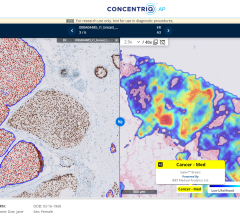
Talk about a bad day. As if a natural disaster were not enough, the Federal Emergency Management Agency (FEMA) came to help.
During a session titled “Shanghaied by FEMA: Emergency Preparedness Gone Bad,” which was held July 23 at AHRA 2019, Wendy J. Stirnkorb described what happened when Hurricane Katrina caused a hospital in Fairhope, Ala., to evacuate.
FEMA filled the void, she said, taking over the nearly vacant hospital as its base of operations.
“FEMA brought the National Guard but they didn’t bring housekeeping,” Stirnkorb told the AHRA audience. “We made a lot of sandwiches for them and for doctors, staff and patients.”
The change in leadership was … different, she explained to Imaging Technology News. “It was do this, ‘Yes sir’ and off you go,” she recalled, “whether that was making sandwiches or cleaning blood up off the OR floors.”
The current director of imaging services and dean of the school of radiologic technology of Regional West Health Services in Scottsbluff, Neb., noted that “we weren’t expecting (FEMA) to utilize our facility; that’s why we evacuated and sent staff home.”
It was the evacuation that made the hospital the ideal location for FEMA.
“Closing a hospital is an extreme act,” Stirnkorb told her AHRA audience “Do you batten down the hatches or do you evacuate?”
To allow objectivity, the decision should be made well in advance. Plans for doing one or the other should depend on the type of disaster and the local circumstances, she said.
Natural disasters such as hurricanes, tornadoes, blizzards, wild fires and earthquakes are all but inevitable in some areas. Unnatural disasters can strike anywhere. Active shooters may stem from domestic violence or bombers from terrorism. Civil unrest may produce riots. Hackers may cyber attack, launching ransomware that holds patient data hostage.
Stirnkorb, who has served in administrative roles at hospitals across the U.S., has experienced both natural and unnatural disasters. Neither is easy to plan for. But the planning must be done. The alternative invites the unexpected.
“Definitely plan for your patients, for your staff and for your facility,” she told ITN.
What To Consider
“Radiology touches every patient that comes into a hospital so we have to make sure that we are prepared,” she said. “Most imaging departments are in the basement or on the first floor so they are going to be impacted first by flooding.”
A weather-related disaster could cause electrical outages and, because imaging depends on electricity, it will pay to know if there is a backup generator and how long it can be expected to run. “Imaging might be a bigger drain than your facility is aware of. So having this conversation is important,” she said.
Also worth considering is the capacity of CTs and portable ultrasound and x-ray units to store images. PACS should be backed up regularly. And off-site servers should be in locations that will not be affected by a local disaster such as a hurricane.
Water pressure at the facility may fail. But nearby fireplugs will have plenty of water and pressure, she noted.
Emergency supplies need to be stocked – but how long should they last? If it takes three days to be resupplied under normal conditions, a ten-day emergency supply should be on hand, she recommended. “Make sure that you have all the supplies that you need, and that your supply chain your procurement process is available and open because that may very well be impacted,” she told ITN.
Radiology departments should also consider whether and what imaging equipment to move. CTs and MRs are too bulky and heavy to move, but not some x-ray and ultrasound equipment. Stirnkorb also recommended stashing a “go” bag that includes essential clothes in your office.
Plan Development
When drawing up plans, consider how specific types of disasters will affect you -- and what you will need to respond. The decision to shelter in place means providing food, sleeping arrangements and showers for staff and possibly their families. “And if you are going to allow their families, does that mean that you’re going to allow their pets?” she asked the AHRA audience.
Staff might be split into A, B and C teams to provide round the clock coverage. Certain modalities, for example, x-ray, ultrasound and CT might have to be available all the time. Thousands of exams may be required in two or three days as the radiology department handles people struck by flying debris during a hurricane, for example.
Along with a staffing plan must be planning to pay the staff. “If they are onsite and working, they should get regular pay,” Stirnkorb said. If they are onsite but ready to work, “they should get on-call pay.”
Preparations should also be made for staff to communicate with their families and those of patients, she said. Security is a must.
Testing and maintaining the plan through monthly drills is critically important. A SWOT (strengths, weaknesses, opportunities and threats) analysis should also be done. It is important to “determine what imaging does well, and how (the imaging staff) can support the rest of facility,” she said.
Radiology should be prepared to share techs to relieve some of the burden from nurses. This will help build camaraderie, she said.
“It is very much a team effort,” she said. “If it wasn’t before, it certainly will be during a disaster
Greg Freiherr is a contributing editor to Imaging Technology News. Over the past three decades, Freiherr has served as business and technology editor for publications in medical imaging, as well as consulted for vendors, professional organizations, academia, and financial institutions.
Editor’s note: This article is the sixth piece in a content series by Greg Freiherr covering The Association for Medical Imaging Management (AHRA) annual meeting in Denver. The first article, How Standardizing Protocols Can Save Time and Money, can be found here. The second article, How Artificial Intelligence Might Impact Radiology, can be found here. The third article, How To Manage Risk in the MR Suite, can be found here. The fourth article, DR Advances Promote Imaging of Whole Spine, can be found here. The fifth article, Payment Models Seek Traction in Transition from Volume, can be found here. The sixth article, Liars in Radiology Beware! can be found here.
Related AHRA and Radiology Management Content:
FFR-CT: Is It Radiology or Cardiology?
Payment Models Seek Traction in Transition from Volume
DR Advances Promote Imaging of Whole Spine
How Standardizing Protocols Can Save Time and Money
How Artificial Intelligence Might Impact Radiology
How To Manage Risk in the MR Suite
CMS Proposes New Alternative Payment Model for Radiation Oncology
Johns Hopkins Named Qualified Provider-led Entity to Develop Criteria for Diagnostic Imaging



 July 15, 2025
July 15, 2025 








